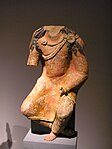The Kumtura Thousand Buddha Caves (simplified Chinese: 库木吐喇千佛洞; traditional Chinese: 庫木吐喇千佛洞; pinyin: Kùmùtǔlǎ Qiānfódòng) (also Qumtura) is a Buddhist cave temple site in the Autonomous Region of Xinjiang, China. The site is located some 25 km west of Kucha, Kuqa County, on the ancient Silk Road.[1][2] Other famous sites nearby are the Kizilgaha caves, the Kizil Caves, Subashi Temple and the Simsim caves.[3]
 Kumtula Grottoes | |
| Location | Xinjiang, China |
|---|---|
| Coordinates | 41°42′42″N 82°40′42″E / 41.7117°N 82.6784°E |
112 cave temples survive, dating from the fifth to the eleventh centuries. Damaged by occasional habitation after abandonment of the site, Kumtura was visited by a number of the early foreign expeditions to Chinese Central Asia, including the 1902 Ōtani expedition, Oldenburg, and Le Coq.[4][5][6][7] The last detached several wall paintings and took them back to Berlin (now at the Museum für Asiatische Kunst).[8]
Construction of the Dongfang Hong Hydroelectric Plant in the 1970s caused the water level of the Muzat River to rise and has increased the rate of decay of the wall paintings.[1] Long-term preservation measures under the auspices of UNESCO began in 1999 with extensive documentation and survey work and consolidation of the conglomerate rock from which the caves are excavated.[1][9] The site was among the first to be designated for protection in 1961 as a Major National Historical and Cultural Site.[10] In 2008 Kumtula Grottoes was submitted for future inscription on the UNESCO World Heritage List as part of the Chinese Section of the Silk Road.[11]
Gallery
- Kumtura Caves overview
- The Kumtura Grottoes are located along the Muzat River.
- Kumtura Caves, sample plan
- Headless statue from Kumtura at the Museum für Asiatische Kunst, Berlin
- Donors in Hephthalite style, Kumtura Caves. Similar donors can be seen in the Kizil Caves.[12][13] Circa 500 CE.[14][15]
- Group of donors in Tocharian clothing, Kumtura Caves.
- Dignitary seized by soldiers. Kumtura painting, 8th-9th century CE
- Statuettes of Devatas, Kumtura
- Man in royal attire, Kumtura Caves
- Kumtura deity (dome)
- Kumtura deity (dome)
- Fresco on the dome
See also
References
External links

- Kumtura Thousand Buddha Caves Conservation Project (UNESCO)
- Conservation of Ancient Sites on the Silk Road (1st Conference) (GCI)
- Conservation of Ancient Sites on the Silk Road (2nd Conference) (GCI)
- Xinjiang Cultural Relics Bureau (search term: 库木吐喇千佛洞) Archived 2018-12-11 at the Wayback Machine (in Chinese)
- Xinjiang Travel: Reliable & Authentic Guide from Local Travel Experts













